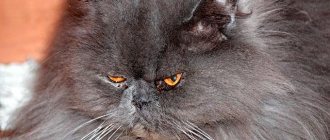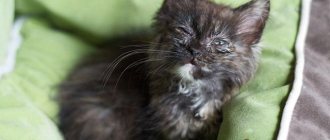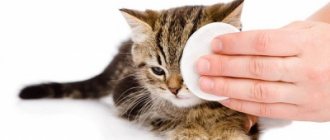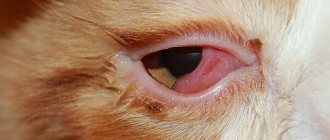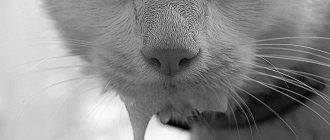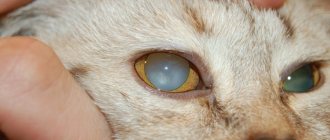Conjunctivitis is an inflammation of the thin mucous membrane covering the eyeball and the adjacent surfaces of the eyelids. This connective membrane, or conjunctiva, is normally transparent and colorless; it serves to moisten the cornea with a liquid mucous secretion, which is produced by the own glands of the conjunctiva in addition to the secretion of the main lacrimal glands. The conjunctiva receives nutrition from blood circulation in a network of small, almost invisible vessels, closely connected with the blood supply system of the eyelids. Inflammatory processes in this important structural element of the visual system manifest themselves as symptoms common to all conjunctivitis, due to the anatomical structure of the conjunctiva (redness of the eyes due to swelling and blood filling of the vascular network, characteristic turbidity, discomfort in the eye, increased lacrimation), and specific, due to cause and source of inflammation (presence/absence of purulent exudate, itching or pain, photophobia or swelling of the eyelids, etc.). Finally, some forms of conjunctivitis, for example, chlamydial in the early stages, can be practically asymptomatic for a long time.
Fig. 1 Preparations in the form of eye drops and ointments are the main method of treating conjunctivitis
The nature and pathogenic properties of the damaging factor, as well as the type of conjunctivitis (acute or chronic), determine the therapeutic approach. Thus, along with the elimination of general symptoms (anti-inflammatory, desensitizing, and, if indicated, moisturizing drugs) for conjunctivitis, etiopathogenetic measures should always be taken to eliminate the causes of inflammation. Therefore, the primary task of an ophthalmologist is usually to study the medical history, differentiate between various suspected types of conjunctivitis, and clarify diagnostics (for example, bacterial culture or serological testing to accurately identify the causative agent of the infectious-inflammatory process).
Thus, the clinical picture, the most likely dynamics of development, and the response therapeutic strategy depend on the etiological causes of conjunctivitis. In addition, the etiological criterion underlies the generally accepted typological classification of conjunctivitis. So, below are the most common types of conjunctivitis and the most effective means of treating it today. It should be emphasized that this information is provided for informational purposes only and can in no way be used as recommendations for self-medication.
Fig. 2 Antibacterial drops - a mandatory component of treatment
Watery eyes in a cat: possible causes
If there are no other symptoms, your cat's watery eyes are not a cause for concern. If the animal’s behavior has not changed, the discharge is transparent and does not bring discomfort to the pet - it does not squint or rub its eyes, the solution to the problem can be regular hygiene procedures. Caring procedures do not involve frequent rinsing with water - this can lead to changes in microflora and inflammation. You should not use cotton wool during the cleaning process - its fibers can get into the eyes. It is best to perform eye hygiene using a soft cloth or paper towel.
Excessive lacrimation is considered normal in cats of short-headed breeds - Persian, exotic, British, Scottish. In such animals, the channels through which tears pass in the normal structure of the muzzle are deformed. Therefore, tears cannot pass through them normally and leave them in a timely manner.
Quite profuse lacrimation is typical for certain breeds of cats - “Persians”, exotics, “British” and “Scottish”
The so-called morning tears, when after a night's rest you can detect minor whitish accumulations, should not cause concern. Usually the pet gets rid of them on its own by washing it in the morning.
Pathological causes of lacrimation and their symptoms
The main pathological causes leading to excessive discharge from the eyes include:
- Conjunctivitis. It is an inflammation of the inner mucous membrane of the eye and is accompanied, in addition to lacrimation, by redness and swelling. The animal often rubs its eyes, blinks and squints. After sleep, the eyelids stick together. In most cases, conjunctivitis is one of the manifestations of a serious disease.
- Activity of parasites. Neglecting anthelmintic treatment can lead to your pet becoming infected with worms. In this case, there is usually swelling of only one eye and profuse lacrimation.
- Keratitis. If the eyes are covered with a cloudy film, redness and discharge are observed, then most likely the cornea is inflamed. Trauma or infection can lead to the development of this disease.
- Blepharitis. The primary symptoms of the disease, which is an inflammation of the eyelids, include itching and redness. In the absence of therapy, profuse lacrimation begins, crusts and swellings form. This pathology is often confused with conjunctivitis; a specialist can make the correct diagnosis.
- Allergy. In addition to lacrimation, reactions to external irritants can include itching, rash, sneezing, shortness of breath and even vomiting.
- Infectious diseases. Chlamydia or calcivirus can cause lacrimation. The first disease is also accompanied by fever, nasal discharge, and cough. Calcivirosis is characterized by fever, lethargy, lack of appetite, inflammation of the gums, and sometimes lameness develops.
- Respiratory diseases. Watery eyes may be a consequence of a cold. In this case, it is accompanied by sneezing, coughing and fever.
- Injuries and foreign objects. Street travel and fights can cause damage to a cat's eyes or a foreign object getting into them. In addition to copious tears, injury is accompanied by swelling, redness, and clouding of the eye. If the injury is serious, the animal meows in pain and constantly rubs the problem area. In addition to tears, pus or blood may flow from the animal's eyes.
- Congenital structural anomalies. The incorrect structure of the eyelid, when it either turns strongly inward and irritates the conjunctiva, or, conversely, turns outward, opening access to dirt and external irritants, leads to lacrimation.
- Glaucoma. When intraocular pressure increases, in addition to discharge, redness and clouding of the lens are observed.
- Cataract. This is a fairly rare disease in cats. Its development is typical for older animals. Cataracts are incurable, but if detected at an early stage, it is possible to significantly slow down the clouding process.
Tearing that suddenly appears and does not go away within 1-2 days, accompanied by other symptoms - lethargy, fever, lack of appetite, fear of light, coughing and sneezing, the appearance of pus, eye injury or foreign object - is a reason to visit a specialist.
Eye drops and ointments for allergic conjunctivitis
In case of allergic conjunctivitis, it is necessary, first of all, to eliminate or minimize contact with the allergen. To relieve symptoms, antihistamine H1-blockers are prescribed to suppress the allergic reaction:
- drops Allergodil, Opatanol, Cromohexal, Lecrolin, Ketotifen, etc.;
- decongestant and vasoconstrictor drops (Vizin, Visomitin, Oksial);
- eye ointments, incl. hormonal (Hydrocortisone, Dexamethasone);
Tablets of systemic antihistamines (for example, Tavegil, Suprastin, Loratadine and their analogues) may also be prescribed.
Preventive measures
To avoid eye problems in cats, you need to pay regular attention to their examination and hygiene. Do not neglect quarterly deworming and vaccination. To prevent the development of any pathologies, you should show your pet to a specialist once every six months - as you know, the disease is easier to cure at an early stage.
If you have the slightest problems with your cat’s eyes, it is better to show the animal to a specialist - you should not experiment with the health of your pet. The favorable outcome of any disease largely depends on competent and timely therapy.
How to wipe and rinse a cat's eyes
If eye treatment for kittens has already been prescribed and you carry out the procedures at home yourself, then we offer you a short instruction.
Read also: 7 myths about online installment plans
You will need:
- gauze pads/cotton pads;
- pipette/disposable syringe;
- towel;
- delicacy!
Step 1
Catch and restrain the animal by wrapping it in a towel. Invite someone from your family to join you - you may be surprised by the fact how much strength is hidden in your beloved baby. The towel is designed to soften the desperate resistance of the cat, which hates any manipulation!
Step 2
Start manipulating. Soak the crusts with a napkin or cotton pad soaked in the medicinal solution and remove them.
Step 3
Take a new cloth or disc and soak it in the healing solution. Using your thumb and forefinger, spread your eyelids and rinse them, moving from the outer corner of the eye to the inner corner. Try to ensure that the medicinal solution moistens the conjunctiva generously. If you have experience, then rinsing can be done with a disposable syringe (without a needle), injecting the solution directly under the eyelids.
Symptoms
The disease is manifested by several symptoms: itching of the mucous membranes, sneezing, watery nasal discharge (rhinorrhea), and nasal congestion, and sometimes even conjunctivitis. With obstruction (obstruction syndrome of the human respiratory system), headaches often occur. Allergic rhinitis can lead to complications such as sinusitis.
The causes of rhinitis can be pollen, mold spores, wool, fluff and waste products of animals (cats, dogs, rodents), dust mites, cockroaches.
Asthma is a frequent accompaniment of allergic rhinitis, but it is not yet clear whether a false runny nose is the cause of asthma or whether both of these diseases are based on the same cause - the allergic process. With asthma accompanying hay fever, the patient may experience shortness of breath and a severe cough.
External factors of tearing eyes
In addition to internal reasons associated with diseases and features of the anatomical structure of the visual analyzer, there are external factors that increase tear production. Conventionally, they can be divided into two groups. The first is foreign objects trapped under the eyelid. A cat cannot always remove specks, dust, and dirt on its own. Sharp objects can mechanically injure the eye. If foreign particles linger on the mucous membrane, they cause itching, redness, and inflammation. Increased tear production in such a situation is a physiological reaction of the body. The liquid helps to wash out foreign matter.
The second group of irritants does not reach the mucous membrane directly. Tear secretion begins under the influence of volatile compounds contained in the air. The reason may be the aromatization of the room, chopping onions, the release of an increased amount of natural gas, smoke from cigarettes or a fire. There is no need to treat the cat, just rinse the eyes with saline solution.
Allergic rhinitis - what is it?
Allergic rhinitis (popularly called “hay fever”) is an inflammation of the nasal mucosa due to various allergens. Determining that it is allergic rhinitis ( runny nose
) is quite simple: if a person does not have signs of inflammation, but has symptoms of rhinitis, then most likely it is hay fever. Sometimes it is almost impossible to understand which allergen causes rhinitis, because the patient is sensitive to several groups of allergens at once (polysensitization). In this case, you need to immediately visit a doctor so that he can prescribe the correct treatment, since just removing certain allergens may not be enough.
Treatment of tearing in cats
The nature of the treatment depends entirely on the cause of the pathology. If problems are detected with the anatomical structure of the nasopharynx, resulting in lacrimation and difficulty breathing, the doctor may even prescribe surgical intervention. In other situations, treatment is not difficult.
If an allergic reaction is detected, you need to get rid of the allergen and prescribe antihistamines.
If there are injuries or a foreign object is found in the eye, the wound should be treated and the object removed.
If an infection is detected, your doctor may prescribe antiviral medications or antibiotics. It is important to understand that there are diseases that require not only local treatment, but also general treatment.
Cataracts, increased intraocular pressure, and keratitis are most often treated with drops. The drug and dosage are selected individually, taking into account the general condition of the animal.
Treatment at home
When infectious eye diseases are detected in cats, they are prescribed instillation and rinsing with aqueous solutions of antibiotics:
- Sofradex;
- Sulfacyl sodium;
- Kanamycin;
- Levomycetin.
In this case, not only the affected eye is treated, but also the second one, even if it looks healthy. Apply an antibiotic ointment (for example, tetracycline) 2-3 times a day and wipe the eyelids with Furacilin solution. In case of severe swelling of the eyelids and severe pain, a solution of hormones (hydrocortisone and novocaine) is injected into the animal’s eyeball. Such procedures are carried out in a hospital.
If a foreign body gets into the pet's eye, the veterinarian removes it with a cotton swab, injection needle or tweezers, and then injects an anesthetic into the eyeball.
Excessive lacrimation caused by an allergen is treated with antihistamines and hormonal ointments.
As additional remedies to basic medications, some cat owners use tinctures and decoctions of beneficial herbs. For example, sage, chamomile, St. John's wort, calendula. They wash your pet's eyes twice a day. The procedures help get rid of pus, stop inflammation, and heal affected mucous membranes. Instead of herbal recipes, it is allowed to use strong brewed black tea or a weak solution of manganese.
Treatment and prevention of diseases of the organs of vision
Everyone knows the golden rule of medicine: the first step to recovery is an accurate diagnosis. This means that the best way to treat a cat whose eyes are watery is to visit a veterinarian. He will examine the eye, perhaps take tests and ask about the disease, how it started and how it progressed. And only after that he will decide what to appoint.
What can help if a cat's eyes are running?:
- Rinsing the eyes with warm chamomile decoction;
- Washing with furatsilin;
- Boric acid solution (for 50g of warm water you need 1 tsp of 0.02% acid).
These remedies are gentle. They sometimes need to be used as a preventive measure. The main condition is that the cotton wool or bandages do not damage the eyes. That is why the tampon is dipped in solutions and decoctions. And they don’t rub it over the eye, but squeeze it out to drop it into the eye. And this needs to be done several times. It is advisable to use a new cotton swab for this.
If the problem is more complex, then washing alone will not be enough. You need to carefully pull back the lower eyelid and apply antibiotic cream there. What products: creams and drops are recommended to be used if cats have tears:
Painful tearing
Experienced breeders know that if a cat has one eye watering for a long time, this is a sign of a serious pathology:
- Cold. Animals often have watery eyes if they are hypothermic and have contracted the virus. In addition to eye discharge, body temperature rises. The pet refuses food and constantly sleeps.
- Conjunctivitis is an infectious disease caused by pathogenic microflora, for example, staphylococci or chlamydia. As a rule, with such an ophthalmological pathology, the cat is afraid of bright light, hides under the sofa or bed, and has watery eyes in one or both eyes. The veterinarian will determine what to do.
- Worm infestation. Intestinal parasites very often cause excessive tearing in pets. They affect not only the digestive tract, but also settle in the visual organs, causing severe suppuration and inflammation. The owner immediately notices that the cat’s eye is swollen and watery. After antihelminthic therapy, these symptoms disappear.
- Trichiasis is a rare pathology characterized by abnormal eyelash growth in cats. They appear inside the eyelid, irritate the tear ducts, and cause infection. The animal constantly rubs its eyes and squints. The problem can only be solved surgically. Simple rinsing with medicinal or folk remedies does not help in such a situation.
- Entropion of the eyelids is a problem that often appears in Sphynxes and other hairless breeds. It can only be solved surgically. Antibacterial therapy is carried out after the operation. After a few days, the animal’s vision is completely restored, and all unpleasant symptoms disappear.
- An allergic reaction often causes swollen eyelids in pets and excessive tear production. It is triggered by various allergens: pollen, household chemicals, cosmetics, especially aerosols, new food with additives, tobacco smoke, poplar fluff or household dust. The pet's eyes become red, frequent sneezing and scabies appear. To save him from suffering, they are treated with antihistamines and, if possible, protect the pet from contact with irritants.
- Chemical or thermal burns of the eyelids and cornea. Pets get such injuries if household chemicals, all kinds of solvents, dyes, and varnishes come into contact with their faces. Before sending to the veterinarian, you need to find out what solution the pet was burned with - alkaline or acidic. If alkali gets into a cat's eyes, at home they are washed with an aqueous solution of boric acid, and if the eyelids are burned by acid, a soda solution is suitable. When you don’t have such products at hand, it’s enough to rinse the face with plain tap water.
- Foreign objects. If your cat's eye is red and watery, it could be a piece of hard food, a splinter of wood, a speck of sand, or sand. They rupture the membranes of the eyelid, cause inflammation, swelling, and activate the production of tear fluid. To remove foreign objects, the pet's eyes are washed with running water and then wiped with an antibiotic solution. If the cornea is seriously damaged, independent actions can only cause harm and cause complete blindness.
- Injuries. Very often, if several mature cats live in a house, clashes and fights occur, as a result of which the pets injure each other’s eyelids with their claws. It often happens that a cat's red eye becomes watery after a walk. He could have been injured by a dry branch on a tree or a stem in the grass.
Important! In any case, if pathological symptoms appear in a pet, a veterinarian examination is necessary. He will examine the cornea and determine the extent of damage to the eye. If conjunctivitis is suspected, an analysis of the eye fluid will be required to determine the causative agent - fungi, bacteria or viruses. In special cases, an ultrasound of the eyes, tests for the patency of the lacrimal ducts, and ophthalmoscopy are performed.
How is diagnosis carried out?
There are two ways to determine allergies - by blood test and by skin testing. Skin tests can be either superficial: applying the allergen to scratched skin, or injection: injecting it under the patient’s skin. All procedures are carried out under the supervision of an allergist to monitor the patient’s condition.
The skin reaction usually appears approximately 30 minutes after the start of the test. A blood test is used when the age or health of the patient does not allow skin testing. This allows you to minimize risks. The blood test is done over several days.

